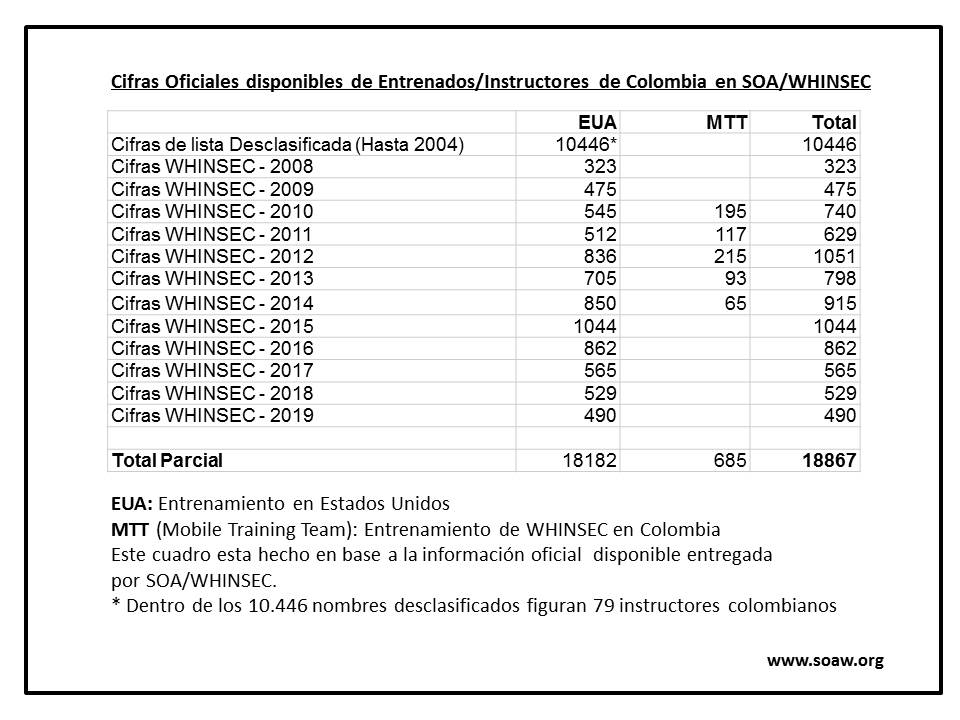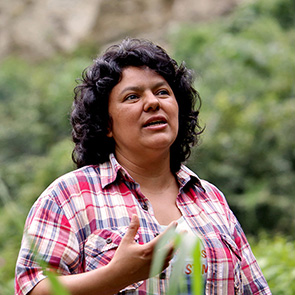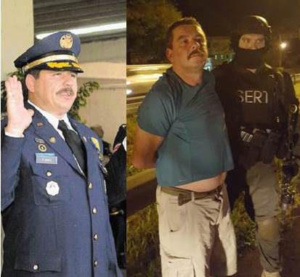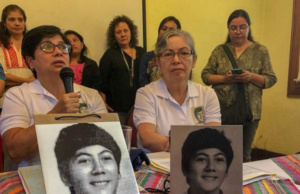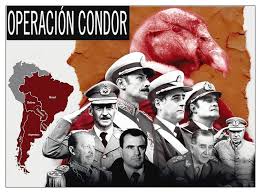By Lisa Haugaard, Covert Action Quarterly
Several recently declassified US military training manuals show how US agents taught repressive techniques and promoted the violation of human rights throughout Latin America and around the globe. The manuals provide the paper trail that proves how the US trained Latin American and other militaries to infiltrate and spy upon civilians and groups, including unions, political parties, and student and charitable organizations; to treat legal political opposition like armed insurgencies; and to circumvent laws on due process, arrest, and detention. In these how-to guides, the US advocates tactics such as executing guerrillas, blackmail, false imprisonment, physical abuse, using truth serum to obtain information, and paying bounties for enemy dead.
Counterintelligence agents are advised that one of their functions is “recommending targets for neutralization,” a euphemism for execution or destruction.
On September 20, 1996, the Pentagon released seven training manuals prepared by the US military and used between 1987 and 1991 for intelligence training courses in Latin America and at the US Army School of the Americas (SOA), where the US trains Latin American militaries.
The manuals’ discovery has helped reinvigorate grassroots, religious, and congressional efforts to close the US Army School of the Americas. It proves on paper what so many have said for so long-that US training contributed to the devastating human rights violations in the region. Although Latin American militaries were perfectly capable of violating human rights and democratic principles without US sponsorship, the anti-democratic training methods advocated by the US provided -at the very least-a green light for repression. And for decades, the traffic was heavy. Techniques of control contained in the manuals were actively adopted by Latin American militaries, particularly in the 1970s and 1980s; in Chile’s and Argentina’s “dirty wars” in which thousands of dissidents disappeared; by military dictatorships in Brazil, Paraguay, and Uruguay; in the Central American wars, where tens of thousands of civilians were killed; and in the Andean countries, where human rights violations still abound. In most cases, the militaries being trained not only suppressed armed rebellion but also repressed democratic, civic opposition.
Paper Trail
The paper trail begins with the mysterious “Project X.” Like the Army manuals, the Project X materials “suggested militaries infiltrate and suppress even democratic political dissident movements and hunt down opponents in every segment of society in the name of fighting Communism,” according to the Washington Post.
At least some of these teaching materials were pulled from circulation by the Carter administration, which was concerned they would contribute to human rights abuses in Latin America. In 1982, the Reagan administration asked the SOA to rush out a new counterintelligence course for Latin American militaries. The instructor asked to develop the course, Capt. Vic Tise, turned to Project X materials, stored at Fort Huachuca, Arizona, and updated them into lesson plans.
In 1987, the 470th Military Intelligence Brigade took the SOA lesson plans and turned them into textbooks: Handling of Sources, Guerrillas and Communist Ideology, Counterintelligence, Revolutionary War, Terrorism and the Urban Guerrilla, Interrogation, Combat Intelligence, and Analysis 1. These manuals were then used by US trainers in Latin America and distributed to Latin American intelligence schools in Colombia, Ecuador, El Salvador, and Peru. They came full circle back to the SOA in 1989 when they were reintroduced as reading materials in military intelligence courses attended by students from Bolivia, Colombia, Costa Rica, the Dominican Republic, Ecuador, Guatemala, Honduras, Mexico, Peru, and Venezuela. The US government estimates that as many as 1,000 copies may have been distributed at the SOA and throughout Latin America.
From start to finish, six of the seven Army manuals are how-to-guides on repressive techniques. Throughout their 1,100 plus pages, there are few mentions of democracy, human rights, or the rule of law. Instead, there are detailed techniques for infiltrating social movements, interrogating suspects, surveillance, maintaining military secrecy, recruiting and retaining spies, and controlling the population. While the excerpts released by the Pentagon to the press are a useful and not misleading selection of the most egregious passages-the ones most clearly advocating torture, execution, and blackmail-they do not reveal the manuals’ highly objectionable framework. In the name of defending democracy, the manuals advocate profoundly undemocratic methods. Just as objectionable as the methods they advocate is the fundamental disregard for the differences between armed insurgencies and lawful political and civic opposition-an attitude that led to the deaths of hundreds of thousands of Latin American civilians.
Opposition = Revolution
The Counterintelligence manual, for example, defines as potential counterintelligence targets “local or national political party teams, or parties that have goals, beliefs or ideologies contrary or in opposition to the National Government”, or “teams of hostile organizations whose objective is to create dissension or cause restlessness among the civilian population in the area of operations.” This text recommends that the army create a “blacklist” of “persons whose capture and detention are of foremost importance to the armed forces.” It should include not only “enemy agents” but also “subversive persons,” “political leaders known or suspected as hostile toward the Armed Forces or the political interests of the National Government,” and “collaborators and sympathizers of the enemy,” known or suspect.
Throughout, the manuals highlight refugees and displaced persons as possible subversives to be monitored. They describe universities as breeding grounds for terrorists, and identify priests and nuns as terrorists. They advise militaries to infiltrate youth groups, student groups, labor unions, political parties, and community organizations.
Even electoral activity is suspect: The insurgents “can resort to subverting the government by means of elections in which the insurgents cause the replacement of an unfriendly government official to one favorable to their cause”; “insurgent activity” can include funding campaigns and participating in political races as candidates.
One of the most pernicious passages, in “Combat Intelligence”, lists ways to identify guerrilla presence. “Indicators of an imminent attack by guerrillas” include demonstrations by minority groups, reluctance by civilians-including children-to associate with US or their local troops, celebrations of national or religious festivals, or the presence of strangers. “Indicators of control by guerrillas” over a certain civilian population include the refusal to provide intelligence to government forces or the construction of new houses. Indications that insurgents are conducting psychological operations include accusations of government corruption, circulating petitions, attempts to discredit the government or armed forces, calling government leaders US puppets, urging youth to avoid the draft, demonstrations or strikes, or accusations of police or army brutality.
A Purely Military Response
Civil society and government, too, are often viewed simply as impediments to military control. With no mention of the propriety of the practices, a number of the manuals advocate controlling information through censorship as well as by spying on and infiltrating civilian groups. In general, the population is a source of information at best, an enemy force at worst. The civilian government fares little better; it is one more entity to be reported on or pushed aside. Ways to impose curfews, military checkpoints, house-to-house searches, ID cards, and rationing are presented without reference to laws or the role of the legislature. Indeed, there is little discussion of the proper relationship between a civilian government and military authorities.
Much more effort is put into the role of the army in quashing revolutionary tendencies. Several of the manuals teach militaries and intelligence services how insurgencies develop and how to control them. The description of the former is generally simplistic and dated, with few references to the role official repression plays in fueling insurrection. The brief histories of El Salvador and Guatemala, for example, in “Terrorism and the Urban Guerrilla” skip over repression, human rights violations, or problems in democratic governance that contributed to the growth of revolutionary movements. Insurgents are reduced to manipulators of popular discontent, in thrall to Soviet style Marxism. While “Combat Intelligence” offers a more sophisticated explanation of the underlying reasons for revolutionary movements-such as the strains created by rapid modernization, the existence of corrupt elites and government repression-neither this manual nor any other suggests steps a civilian government might take as a political response to popular discontent. There is no limitation on when to use military and counterintelligence methods.
From Bad to Worse: The CIA Manuals
The two recently declassified CIA manuals make even more chilling reading. The CIA had written KUBARK Counterintelligence Interrogation in 1963 for use by US agents against perceived Soviet subversion. (KUBARK was the CIA’s code name for itself. ) While it was not intended to train foreign military services, its successor, Human Resource Exploitation Training Manual — 1983, which drew heavily on material in KUBARK, was used in at least seven US training courses conducted in Latin American countries between 1982 and 1987, according to a June 1988 memo placed inside the manual. This 1983 manual originally surfaced in response to a June 1988 congressional hearing which was prompted by allegations by the New York Times that the US had taught Honduran military officers who used torture. The 1988 hearing was not the first time such manuals had surfaced. In 1984, a CIA manual for training the Nicaraguan Contras in psychological operations created a considerable scandal.
These two CIA textbooks deal exclusively with interrogation and devote an entire chapter each to “coercive techniques.” Human Resource Exploitation recommends surprising suspects in the predawn hours, arresting, blindfolding, and stripping them naked. Suspects should be held incommunicado, it advises, and deprived of normal routines in eating and sleeping. Interrogation rooms should be windowless, sound proof, dark, and without toilets. The manuals do admonish that torture techniques can backfire and that the threat of pain is often more effective than pain itself. However, they then go on to describe coercive techniques ”to induce psychological regression in the subject by bringing a superior outside force to bear on his will to resist.” These techniques include prolonged constraint, prolonged exertion, extremes of heat, cold, or moisture, deprivation of food or sleep, disrupting routines, solitary confinement, threats of pain, deprivation of sensory stimuli, hypnosis, and use of drugs or placebos.
According to the Baltimore Sun, “the methods taught in the 1983 manual and those used by [the US-trained Honduran] Battalion 316 in the early 1980s show unmistakable similarities.” The paper cites the case of Ines Murillo, a Honduran prisoner who claimed she was held in secret jails in 1983, given no food or water for days, and kept from sleeping by having water poured on her head every ten minutes.
Dismissive of the rule of law, Human Resource Exploitation Training Manual-1983 states the importance of knowing local laws on detention, but then notes, “Illegal detention always requires prior [headquarters] approval.” The manual also refers to one or two weeks of “practical work” with prisoners as part of the course, suggesting that US trainers may have worked with Latin American militaries in interrogating actual detainees. This reference gives new support to the claims by Latin Americans held as prisoners and by US nun Dianna Ortiz, tortured by the Guatemalan army in 1989, that US personnel were present in interrogation and torture rooms.
In 1985, in a superficial attempt to correct the worst of the 1983 manual, a page advising against using coercive techniques was inserted and handwritten changes were haphazardly introduced into the text. For example, “While we do not stress the use of coercive techniques, we do want to make you aware of them and the proper way to use them,” has been coyly altered to, “While we deplore the use of coercive techniques, we do want to make you aware of them so that you may avoid them.” But the entire chapter on coercive techniques is still included, again with some items crossed out. Throughout, the reader can easily read the original underneath the “corrected” items. These corrections were made in response to the 1984 scandal when the CIA training manual for the Contras hit the headlines.
The second manual, KUBARK Counterintelligence Interrogation, is clearly the source of much of the 1983 manual; some passages are lifted verbatim. KUBARK has a similar section on coercive techniques, and includes some even more abhorrent elements, such as two references to the use of electric shock. For example, one passage requires US agents to obtain “prior Headquarters approval … if bodily harm is to be inflicted,” or “if medical, chemical, or electrical methods” are to be used. A third condition for obtaining prior approval is, ominously, whited out.
Ignorance as a Defense
While none of the manuals was written or used on the Clinton administration’s watch, the administration so far has failed to send a clear message repudiating such training methods and to take decisive action to ensure that such materials are never developed again. On February 21, 1997, the Department of Defense’s inspector general completed another investigation. It admitted that in creating and using the seven army manuals “from 1982 through early 1991, many mistakes were made and repeated by numerous and continuously changing personnel in several organizations from Panama to Georgia to Washington, D.C.” Without apparent irony, the report concludes that there is no “evidence that a deliberate and orchestrated attempt was made to violate DOD or U.S. Army policies.
The report claims that because these numerous US personnel did not know that it was against US policy to train Latin American militaries to use threats or force with prisoners, “neutralize” opponents, hold prisoners in clandestine jails, and infiltrate and spy upon civilian organizations and opposition political parties-all techniques described in the manuals-no disciplinary action was deemed necessary. The report, which Rep. Kennedy termed a “whitewash” and “hogwash,” does not examine any systemic problem that might have led to “numerous and continuously changing personnel” over a ten-year period lacking a working knowledge of human rights. Thus, the report fails to assign either individual or collective responsibility for training Latin American militaries to violate human rights and use profoundly antidemocratic methods.
While the report concludes that the lesson plans and manuals somehow escaped oversight and could not be read because they were in Spanish, Rep. Kennedy’s own investigation reveals these as mere dog-ate-my-homework excuses. Kennedy’s report states that SOA instructors sent their lesson plans to Fort Huachuca and to at least two offices in Washington to be reviewed, al though the question of whether they were approved in Washington continues to be disputed. Moreover, the materials were approved for use in English before being translated into Spanish.
The report does demonstrate that little was done to implement the recommendations stemming from the 1991 investigation. In three agencies to which they were simply circulated as a memo, there was no record of it having even been received. In three others, it was received but did not result in any increase in oversight of foreign military and intelligence training. However, the report merely calls for the memo to be reissued as a “directive,” rather than stimulating a serious discussion within the military and setting up workable oversight mechanisms.
All of the investigations into the various sets of manuals have been hampered by their basic premise: the disingenuous assumption that these manuals did not represent official US policy and somehow slipped through the cracks. But it was official US policy to train and arm repressive forces in Latin America, Vietnam, and other developing countries. The manuals fit squarely within that framework.
The slow, piecemeal surfacing of these manuals and the limited investigations at each point suggest that there may be many other inappropriate training materials still in circulation. Materials from the most intense days of the Cold War in the 1960s, which should never have been created in the first place, kept on being repackaged and reused despite a series of scandals and investigations that should have forced a full-scale review. That these manuals were used until recently in this hemisphere, however, is hardly shocking. They merely confirm what many long knew about US support for repressive militaries in Latin America. They prove that the United States not only provided the guns and the money for repression; the United States also supplied the textbooks.
